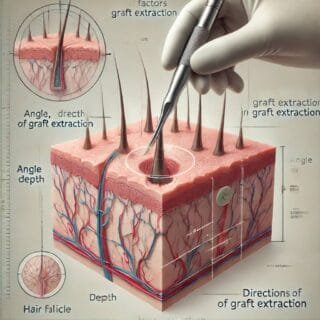Introduction
Are you one of those who have invested a lot of money in hair transplantation but got no or low results? It is a sad thing for anyone who invests for better hair results but it fails. I, Dr. Sandeep Basin, an experienced cosmetologist, always come across my patients complaining about failed hair transplants.
I would like to ask a question: have you wondered why hair transplantation fails for many people? Hair transplantation requires being performed by a qualified surgeon, and no doubt it is done with perfection and expertise.
In this article, we will take you through the key factors that can lead to hair transplantation failures. If you are looking for trusted and professional hair transplant services, explore Hair Transplant in Delhi for the best solutions.
Signs of a Failed Hair Transplant

While a hair transplant can significantly enhance your appearance and boost your confidence, it carries certain risks and may not always proceed as expected. It is therefore important to be able to recognize the signs of a hair transplant that has gone wrong so that you can seek help as early as possible. Here are the key indicators to watch for:
- Failure of hair to regrow or sparse hair density: If the area of the transplanted hair does not grow hair or has very little hair after a few months, then this may be a sign that the procedure did not take place properly.
- Poor hairline layout: An ill-chosen or an unbalanced hairline that does not fit the shape of the face is one of the signs of a failed transplant.
- Dents or lumps: Discoloration, swelling, or other marks on the skin of the head that show visible scars or irregularities in the skin are indications of poor surgery.
- Redness or infection: If you notice that the area is still red, swollen, or you develop signs of an infection, including the presence of pus, then it may be a sign of complications that need treatment.
If you experience any of these symptoms, it is advisable to contact your surgeon as soon as possible. This way, you can address some issues and enhance the results of your transplant.
Why Do Hair Transplants Fail in India?

Hair transplant is gaining momentum in India due to the low cost and the development of techniques used in the process. However, not all the procedures give the desired results, and some of the transplants may fail for one reason or another. Although the outcomes depend on such factors as the experience of the surgeon, the care for the patient, and the quality of the clinic, it is important to know the factors that lead to failures to avoid them.
Here are the most common reasons why hair transplants fail:
- Unqualified Practitioners: This is because many clinics use surgeons or technicians who are not well trained, thus resulting in poor surgery results.
- Improper Graft Handling: Hair follicles are very sensitive and thus need to be handled with a lot of care. When handled improperly during the extraction process or even when kept in storage, it will affect the grafts’ survival rate.
- Hygiene Issues: If proper hygiene is not maintained during the surgery, then there are high chances of developing an infection and also the formation of a scar.
- Lack of Aftercare: If the patient does not adhere to some of the post-operative care instructions that have been given to him or her by the doctor, then he or she will develop certain complications such as poor hair growth or even infections.
- Unrealistic Expectations: This occurs when patients want more than can be obtained from the donor area regardless of the technical quality of the procedure, hence leading to complaints.
Thus, the selection of the proper clinic and surgeon contributes to reducing these probabilities. It is recommended that patients ensure that they confirm the credibility of the clinic, read reviews, and consider the quality of service rather than the cost. Thus, if one does proper research and takes proper care, then the probability of a successful hair transplant is high.
Hair Transplant Death Rate
Hair transplant is one of the safest surgical procedures, with a very low death rate when performed by professionals at reputable clinics. Deaths are rare and typically result from complications such as infections, allergic reactions to anesthetics or other drugs, or untreated medical conditions. Most severe complications occur in unregulated clinics or when performed by unqualified practitioners who fail to follow medical standards.
Patients should disclose any pre-existing medical conditions during the consultation process. Selecting an experienced and qualified surgeon, along with a well-equipped and hygienic clinic, significantly minimizes the risk of complications. When done correctly, hair transplants remain one of the safest procedures in cosmetic surgery.
Why is Graft Extraction Crucial in Hair Transplantation Success Rate?
The Direction, Angle & Depth of Extraction Matter a Lot

You must understand that the depth, direction, and angle of the punch play an important role in extracting your hair grafts. When grafts are extracted from your scalp, your follicle survival rate should be high.
And this is only possible if you have consulted a qualified surgeon. For example, a single graft contains approximately 3 follicles. If your surgeon performs the extraction with perfection, then the chances of follicles being enacted go beyond 90%. In contrast, improper donor area management can lead to damaging your follicle grafts.
We will understand this with an example here. Say two clinics will perform 1000 grafts. One is Dr. Sandeep Basin’s clinic, while another clinic is named ABC.
- Dr. Sandeep Basin is known for his precision and expertise. He skillfully extracts exactly 1000 grafts with 3 follicles intact as it is. This means you get 3000 healthy follicles.
- While clinic ABC does the same process but with imperfections. This leads to extracting grafts between 1000 to 2000 follicles with no intact precision.
You can observe the difference between a skilled surgeon and an unskilled surgeon. The results given above are a huge difference.
If you are going for a hair transplant, then the size of the punch tool will play a major role in extraction. The tool is helpful in the precise extraction of your grafts. In the earlier times, when hair transplantation wasn’t very popular, surgeons used to use large-size punch holes. The punch rolls are generally used to unroll 2 mm.
The Size of The Punch Matters
But today, smaller punch hole tools are used that are about 0.8 mm thin. Have you ever thought about why smaller punch holes matter? Because it avoids scarring and allows higher grafts to be extracted with perfection.
To know more about this, you can also explore post-care tips that directly impact graft survival.
Impact of Hair Transplant Outcomes from Graft Storage

Once your graft extraction is done, the graft storage is important to survival and hair growth rate. We use a specially made tool called the graft-holding solution tool. This tool is laced with vitamins and minerals to protect your grafts. The graft is kept at a temperature of 4 degrees. If the graft is not stored properly, then the chances of it becoming fragile and ineffective are high.
Furthermore, your grafts need to be hydrated occasionally in the entire extraction process. Hydrated grafts will make sure you have strong and healthy follicles. Post-procedure, we recommend consuming a healthy diet to boost recovery. As a surgeon, I do make sure the grafts are hydrated during the entire extraction process. This method protects the follicles and gives a better growth rate.
Hair Density Maximization from Implantation Techniques

Grafts Density & Angles Should be Perfectly Created
When your surgeon performs the extraction process, the graft holes should be close to each other and must be aligned at the right place. (We generally consider a 30-degree angle.) A 30-degree angle makes sure your hair grows naturally. For example, if your angle is 90 degrees, then your hair can spike and expose the scalp, which can damage the plantation results.
Per Square Centimeter of the Grafts Should be Rightly Measured
For a more natural look, the density of the graft matters a lot. We try to aim for 30 to 50 grafts per square centimeter. If the grafts are below these figures, your scalp may look thin and create patchy spots.
Why is Implantation Tool Usage Crucial?
The no-root-touch method is by far the best and most result-oriented technique used for graft implantations. The graft survival rate is about 90%. Let us see a comparison of different technique survival rates.
- Single Forceps: This technique has a survival rate of less than 50%, making it one of the least effective methods.
- Double Forceps: With a survival rate between 70% and 80%, this method offers better results but is still not the most efficient.
- No-root-touch: This is the most advanced and effective technique, achieving an approximate survival rate of 90%.
When direct contact with the grafted root is avoided, your hair damages are reduced, and hair growth becomes successful. You can also explore advanced techniques like Ultra DHI Hair Transplant for more reliable results.
Why Do Expertise and Teamwork Matter in Success Rate?
As said in the above paragraph, hair transplantation is a process that needs precision, expertise, and a skilled professional team. Say, for example, a skilled team can help maintain graft hydration, precise implantation, and assist in making sure all essential tools are available when needed.
If you see, in my clinic, I ensure all my team are working round the clock for a successful hair transplant. However, this may increase your costs, but the results are satisfying and expected. Low-manpower clinics are always the ones that underperform, and the results are low and heartbreaking.
Hair Transplant Failure Rate
The success of hair transplants largely depends on the technique used, the doctor’s experience, and the patient’s adherence to post-surgery care. Globally, failure rates are estimated to range between 5-10%, but this can vary depending on the clinic and region. In India, failure rates might be slightly higher in unregulated clinics or those using outdated techniques.
Common causes of failure include poor handling of grafts, improper extraction or implantation techniques, infections, and unrealistic patient expectations. Additionally, hair loss in areas not treated during the transplant can make the results seem less satisfactory over time.
To reduce the risk of failure, patients should opt for advanced techniques such as FUE (Follicular Unit Extraction) or DHI (Direct Hair Implantation) and choose a skilled surgeon. For a comprehensive overview of the success rate of hair transplants.
Failure of Hair Transplant After Two Years
If the procedure was done right, then hair transplant failure after two years is rare. However, there are some factors that can contribute to poor results within this timeframe. These include the wrong placement of the initial grafts, where the transplanted area does not adequately cover the hair loss. Some people may notice a decreasing effect because the remaining hair continues to shed, making the appearance sparse. Lack of insight into long-term hair loss patterns by the surgeon is also a concern. Such an oversight can lead to inadequate harvesting of donor grafts or an unnatural hairline, which becomes evident after a few years.
Such problems can often be addressed through corrective procedures or therapies like PRP (Platelet-Rich Plasma) therapy to enhance hair density and growth. It is crucial to have routine check-ups with a specialist and follow recommended measures to maintain results over time.
Are You Looking to Consider Hair Transplantation? Here are the Key Factors of Consideration

- We always recommend you consult or choose a skilled and qualified surgeon. The surgeon should be skilled in graft extraction, implantation, storage, etc.
- Cheaper clinics may save you money, but results can become disheartening. Choose quality while overlooking the cost.
- You must make sure your surgeon is using state-of-the-art technology and is an experienced person.
- As said earlier, clinics that aim for a high follicle survival rate are good and experienced. A classic example is the clinic of Dr. Sandeep Basin. For more detailed cost considerations, visit our guide on the cost of hair transplants in Delhi NCR.
Conclusion
It is sad to see people investing a lot of money in hair transplantation with major failures. As a cosmologist, my priority always lies in ensuring your hair transplantation is done with precision and a higher follicle survival rate.
Nevertheless, we suggest you always opt for a quality hair transplant without seeking cheaper options and cutting costs. As discussed in the above sections, different techniques have different follicle survival rates; hence, the best we opt for is the no-root-touch method, which gives around a 90% success rate. For more insights, read about factors affecting hair transplant cost and success.
Are you one of those looking to transplant your hair? Don’t hesitate and consult us today for healthy and dense hair.
Expert Tips to Avoid Hair Transplant Failures
Dr. Sandeep Bhasin shares actionable tips and explains how to achieve the best results from hair transplantation in this detailed video.
FAQs
Failures often happen because of poor technique or inexperienced surgeons. Selecting a skilled expert significantly impacts the outcome.
Yes, it does! Proper angles and depth ensure grafts survive and grow naturally.
Smaller tools (like 0.8 mm) mean less scarring and better precision. Larger ones can damage grafts and look unnatural.
Proper storage keeps grafts healthy. They need to stay hydrated and at the right temperature for the best growth.
For a full, natural look, we aim for 30-50 grafts per square centimeter. Anything less risks looking thin.
The no-root-touch method is the gold standard, with a 90% graft survival rate.
Hair transplants require precision and skill. An experienced surgeon ensures great results, while inexperience leads to poor outcomes.
Absolutely! Saving money with cheaper clinics often means disappointing results. Quality is key for long-term satisfaction.
Yes, with the right techniques! Proper angles and density make all the difference.
Just call us at +91-9667-977-499 or visit Care Well Medical Centre. Let’s get started on your hair journey!
References:
- Garg, A. K., & Garg, S. (2021). Complications of Hair Transplant Procedures—Causes and Management. Indian Journal of Plastic Surgery, 54(4), 477–482. Published online December 31, 2021. Available at: https://www.thieme-connect.com/products/ejournals/pdf/10.1055/s-0041-1739255.pdf.
- Salanitri, S., Gonçalves, A. J., Helene Jr., A., & Lopes, F. H. J. (2009). Surgical Complications in Hair Transplantation: A Series of 533 Procedures. Aesthetic Surgery Journal, 29(1), 72–76. Published January 1, 2009. Available at: https://academic.oup.com/asj/article/29/1/72/295467.
- Lee, M. (2024). A Scoping Review on Complications in Modern Hair Transplantation: More than Meets the Eye. Aesthetic Plastic Surgery. Published online August 2024. Available at: https://link.springer.com/article/10.1007/s00266-024-04316-3.














